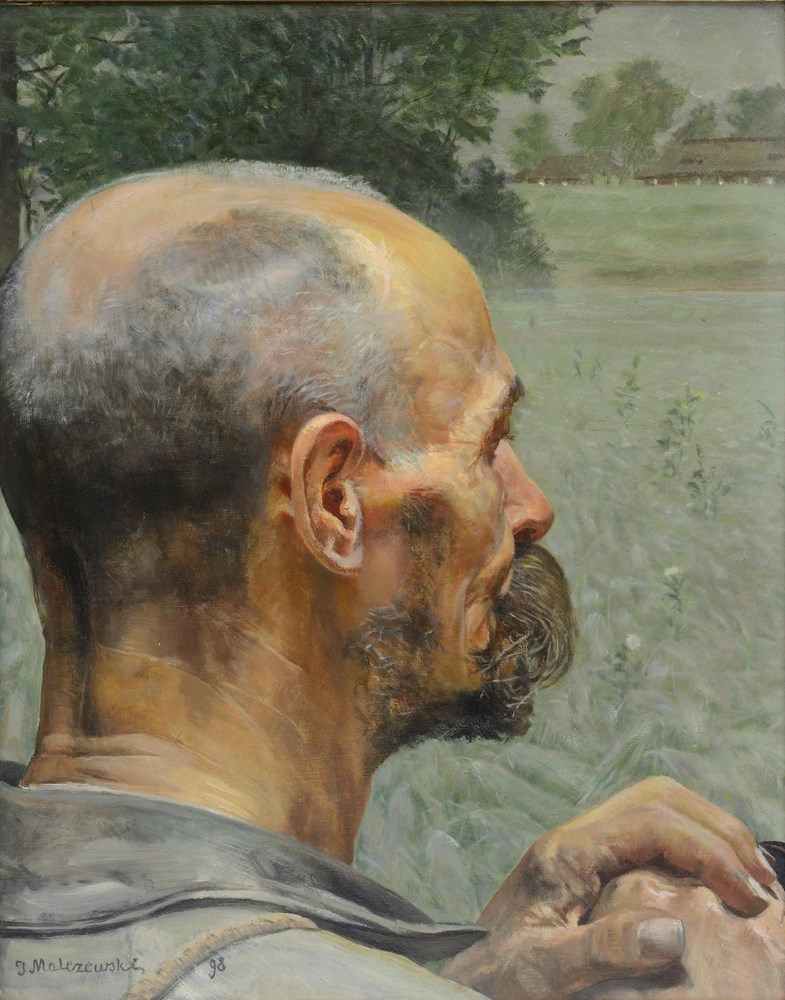Description:
Jack Malczewski (1854-1929) had a fondness for art and romantic literature, particularly the poetry of Juliusz Słowacki, which he inherited from his family home. He came from a Szlachecki family, although a poor one. His father Julian supported him on the path of a painting career. The events of 1863, the January Uprising and subsequent repression, had a particularly strong impact on the young artist. His first teacher was Adolf Dygasiński. He spent his youth from 1867 to 1871 in the manor house of the Karczewski family in Wielgie. In 1873 he began his studies at the School of Fine Arts in Kraków under the guidance of Jan Matejko. He was a student of Władysław Łuszczkiewicz. He also studied at the École des Beaux-Arts in Paris. He traveled to Italy, Vienna, Munich, Greece and Asia Minor. In 1896-1900 and 1910-1914 he was a professor at the Academy of Fine Arts in Kraków. In 1912-1914 he became its rector. He began with idealizing realism, then naturalism, with the main theme of his works in this period being the fate of exiles in Siberia and the inspiration of Juliusz Słowacki’s “Anhellim”. At the same time, fantastic and allegorical views began to appear in Malczewski’s work. After the death of his father in 1884, the recurring theme in Malczewski’s work was Thanatos – the god of death. After 1890 his art became completely symbolic. Works manifesting the turn towards symbolism are: “Introduction” 1890, “Melancholy” 1890-1894, “Vicious Circle” 1895-1897. The artist dealt with existential, historical topics, concerning the position of the artist, his obligations to his homeland and the condition of art. He intertwined Ancient and Biblical motifs with native folklore and the Polish landscape so essential in his works. Form, color, monumentality of presentations and their expression became his hallmark.
In “The Return” we can see a resemblance of the painted head of a man with the features of the artist himself. The depiction of the figure from the back is rarely seen in the portraits created by Jacek Malczewski. The purpose of this trick is therefore worth noticing. It puts the viewer right behind the man’s back, in his direct proximity. This allows for an extraordinary intimate bond, not only physical but also emotional. It is precisely the psychological study of the character that becomes the most important in this approach. The title return does not evoke positive emotions in him. Perhaps this return has not yet come. The man was portrayed in a state of expectation. The landscape and buildings in the background are significant. They bring to mind an Arcadian realm of childhood. The longed-for place of return.
The man’s head taking up almost the entire foreground leaves no doubt that we are dealing with a portrait shot. The portrayed figure remains anonymous, however. In its realistically rendered features one can make out a resemblance to the artist himself. Nevertheless, the model’s identity is not the most important thing here, but rather his feelings.
Description of the painting:
In the painting “Back”, Malczewski presented an exceptional study of a figure. An elderly man with a bald head, adorned with graying hair, thick beard and distinct stubble is shown from behind. His face is almost in profile. We can only see its right part. His gaze is lowered. He looks at the vast expanse of green meadows and fields. He is lost in thought. He is dressed in a gray-brown shirt, on which a fragment of the rope was painted, perhaps the same one with which the fur coats were taken off the shoulders of the Siberian exiles. The hands placed one on top of the other rest peacefully on a wooden cane. The height at which they are painted allows us to conclude that the man has crouched or knelt for a moment.
It is incredibly important to have the background of the presentation. In the distance, Malczewski painted the palace or manor house with clearly marked white elements. However, the man does not look in their direction. What’s more, the title of the work seems to be inappropriate to the scene depicted on it. The painting was created in 1898. Poland was far from regaining its independence. So the painted “Return” did not bring with it happiness, comfort and peace. Sadness and fatigue are visible on the man’s face. The buildings appearing on the horizon may be only an imagination of the native country, the manor in Wielgiem, with which the artist associated the happiest period of his life. So maybe we are dealing with a longed-for and eagerly awaited return, if not of the man himself, then of the person whose return he is expecting, with an unfulfilled desire for return, for which prayers are raised and thought of without respite.


